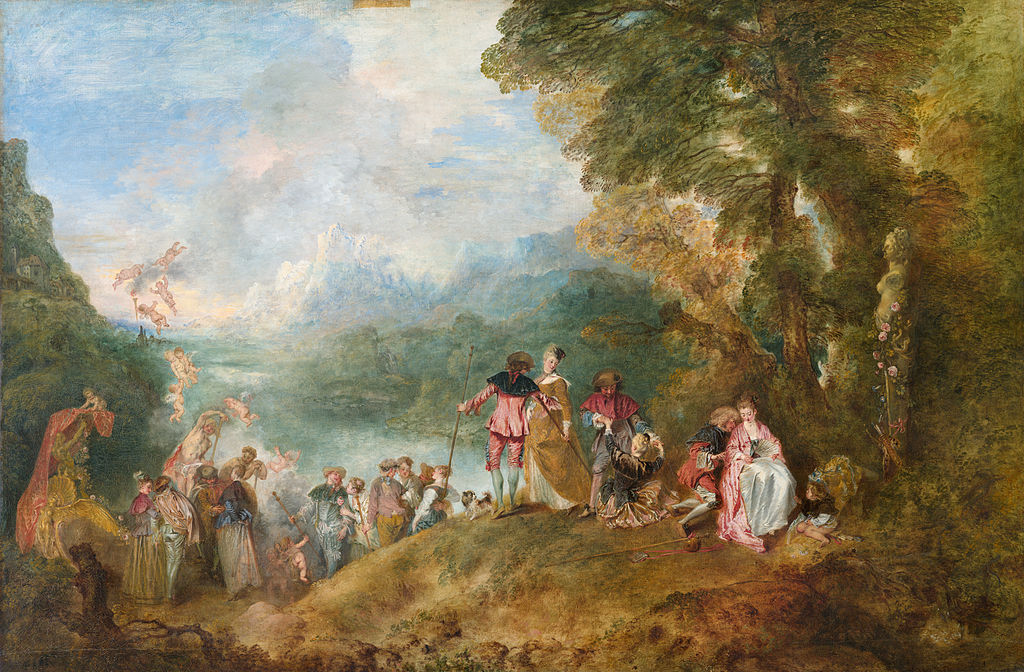The Embarkation for Cythera

Jean-Antoine Watteau (1684-1721) lived a very short, very successful life.
The Embarkation of Cythera was Watteau’s submission in 1717 to London’s Royal Academy as his reception piece – a work submitted for approval as part of the requirements for acceptance as a member.
He had failed on his first attempt, but by his second, this bewitching picture was considered so accomplished that he was instantly granted full membership to the Academy.
The painting would be acquired by the Louvre museum in Paris, and a second version sold to the Charlottenburg Palace in Berlin; in those days it was certainly something of a triumphfor such honour to be bestowed on the unruly son of a roofer.
There was no pre-existing group into which Watteau’s work could comfortably be shoehorned, so the Academy created a new category, fêtes galantes. This genre was adopted to signify art that depicted light and playful courtly scenes set within pastoral backdrops.
It must have infuriated Jean-Antoine’s young rivals to learn that after the Academy had flatly turned him down previously, he was now worthy of being positioned as the central figure in an exciting new movement.
Watteau had demonstrated an interest in painting at a young age. He was apprenticed to a local artist, and the first subjects he was assigned were portraits of street-corner charlatans trying to sell their quack medical remedies.
Following this bracing experience, the young artist moved to Paris in 1702 and found employment in a workshop at Pont Notre-Dame. They specialised in making copies of popular paintings in the Flemish and Dutch tradition, but usefully it was here that Watteau was able to hone and master his sketch-like techniques.
Soon he was to gain a post as assistant to Claude Gillot, a notable artist whose work certainly went against the grain of the establishment approved art of Louis XIV’s reign.
It was Gillot who sparked Watteau’s fascination with the characters of the Commedia dell’arte – a professional theatre form that would become one of his lifelong passions. His wonderful 1719 painting Gilles portrays a dejected-looking Pierrot character gazing balefully at the viewer.
Jean-Antoine then advanced to the workshop of an interior decorator, who was influential in encouraging him to make more sophisticated drawings and etchings. Quickly, he discovered his youthful employee could create them with consummate elegance.
Conscientiously, Watteau continued his grounding by copying works by major sixteenth-century Italian artists in the collection of Pierre Crozat, a wealthy client of the interior designer.
When he settled into his own brief career as a successful painter, he undoubtedly made an abiding impact. Almost singlehandedly Watteau managed to spur the revival of interest in colour and movement, making them as imperative as they had been in the paintings of Correggio and Rubens. He revitalised the Baroque style, making it less severe and more naturalistic.
This is summarised eloquently in The Embarkation for Cythera. Certainly, itwas a ‘fête galante’, picturing an amorous party enjoyed by the aristocracy of France during the Régence. It was the era that clearly focused on pleasure, peace and excess, all that was hedonistic.
The luminous picture of course also celebrates love. Multiple cupids can be seen flying around the couples, some pushing them closer together. The statue to the right is of Venus, the goddess of amorous love, and the viewer can count three pairs of lovers in the foreground, and several more descending down the hill.
The lovers seem to be leaving, rather than arriving. Observers over the centuries have debated whether this indicates they have already paired up, and although many interpretations have been attributed to the work by art historians, Watteau himself purposefully offered no answers or clues.
In the ancient world, Cythera was the mythical Greek island believed to be the birthplace of Venus, and so became sacred to both the goddess herself, and love in general. All are agreed that the work depicts couples on the isle in various stages of their metaphoric ‘journey’ of love.
Watteau used light, feathery brushstrokes, with little indication of the season, as if the lovers are permanently suspended in this unknown moment.
Although Watteau created idyllic scenes, he lacked aristocratic patrons. His collectors were bankers, wealthy businessmen, and other members of the bourgeoisie. Perhaps Watteau’s appeal to this client base was that his paintings depicted figures in the flamboyantly theatrical dress of courtiers, set in verdantly lush, though imaginary, landscapes.
Although he was a highly sought-after artist, making a handsome living simply working as he wished, Watteau was careless about his future and reckless about his financial security.
It alarmed his friends and those closest to him, but it was as if they sensed he was not to live for long, particularly as he grew gradually more sickly.
A journey to London to see a renowned doctor brought little hope. His condition was deteriorating and the city’s damp and smoky air did more damage than medicines could alleviate.
Watteau returned to France in 1721, and died a few months later of tuberculous laryngitis, at just 36.
After his death, Watteau’s art fell witheringly out of favour. The authorities during the build up to the French Revolution deemed that his lavish pastoral escapades were associated with the frivolous and wasteful aristocracy.
The Embarkation for Cythera was used by art students for target practice in the Louvre, who peppered it with bread pellets. The transcendent painting survived, but was safely placed in storage until the 19thcentury to keep it safe from disgruntled protestors.
